How to Properly Install Ceiling Lights: A Step-by-Step Guide
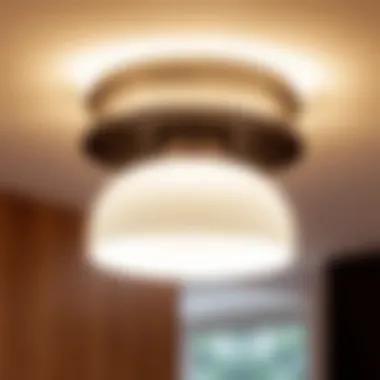
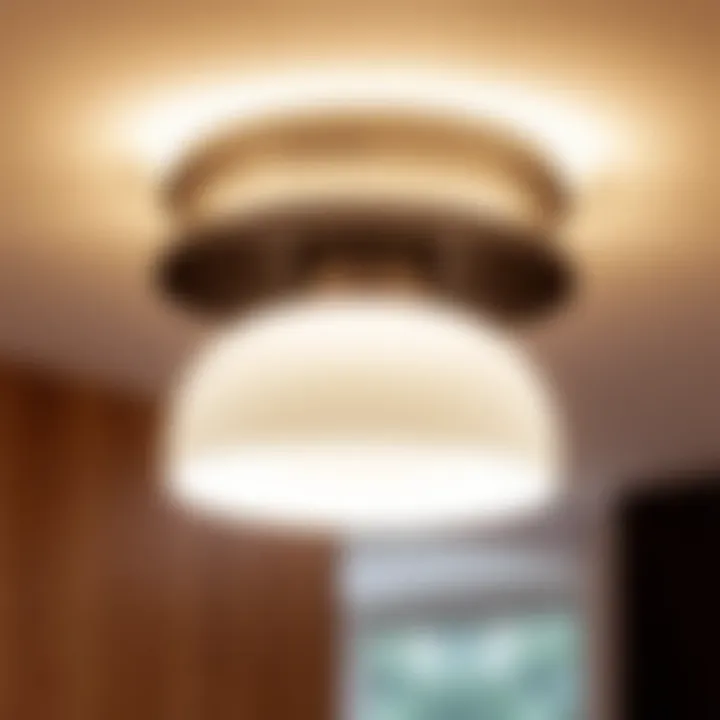
Intro
Hanging ceiling lights can be a game changer in how a room feels and looks. It's not just about illumination; it's about setting a mood, enhancing design, and transforming a space from dull to dynamic. Whether you are a homeowner, a renter looking to add some personal flair, or a DIY enthusiast eager to tackle a new project, understanding how to effectively hang ceiling lights is an essential skill worth mastering.
In today’s world, where the right lighting can significantly affect ambiance and functionality, knowing how to do this correctly pays off immensely. Furthermore, with myriad styles available—think industrial, modern, or even vintage—there's more to consider than just placing a fixture on the ceiling. Choices often depend on the existing decor, purpose of the room, and your unique personal style.
In this comprehensive guide, we will explore the integral steps involved in hanging your light fixtures, from preparation to installation and safety tips to consider. We’ll also unpack some current market trends and popular designs to get your creative juices flowing, making this not just a technical how-to but an aesthetic journey as well.
Grab your toolbox and let's see how proper lighting can elevate your home!
Understanding Ceiling Lighting
Lighting plays a significant role in establishing the atmosphere within a room. When it comes to ceiling lighting, understanding its essential attributes can elevate not just the light's role but the entire aesthetic of a space. Good lighting can make a room feel warm and inviting or cool and modern, entirely altering your perception of the space.
The Importance of Proper Lighting
Proper lighting can transform a mundane area into a vibrant living space. It impacts everything from the mood to productivity. If you've ever struggled to read in a dimly lit room or felt overwhelmed in a space flooded with harsh light, you understand how lighting can affect your experience.
Bright, well-placed lights can enhance features in the architecture, comfort when hosting friends, or simply your day-to-day living. Moreover, energy-efficient lighting options have emerged, ensuring you keep costs low while still achieving that welcoming vibe you’re after.
Different Types of Ceiling Lights
Choosing the right type of ceiling light is akin to selecting a fine wine for dinner – it can make or break the experience. So, let’s delve into the main contenders:
Flush Mounts
Flush mounts are great for low ceilings, keeping things slick and clutter-free. They sit tight against the ceiling, delivering a streamlined look. They often serve as an elegant solution where headroom is of no available luxury. Their simple design means they fit well in various decor styles without shouting for attention. While they might be limited in brightness compared to larger fixtures, multiple flush mounts can easily sufficient light for an average room, combining function with style.
Pendant Lights
In contrast, pendant lights hang from the ceiling, adding a layer of depth to the space. They come in a multitude of styles, from rustic to modern, which allows you to tailor them perfectly to your room's character. A single pendant can act as a statement piece in an entryway or a cluster can gather around a dining table creating ambient allure. However, be cautious with heights; if hung too low, they can impede movement or vision.
Chandeliers
Chandeliers often conjure images of grand dining rooms or luxurious ballrooms, but they can fit quite well in contemporary homes too. Their primary role is to provide abundant light, and they excel when it comes to making a bold statement. This type of lighting can carry elements of ornate design, showcasing your personality. They do, however, require a decent amount of space and proper installation to prevent overwhelming smaller areas.
Recessed Lighting
Recessed lighting, or can lights, provide seamless aesthetics. These fixtures are installed directly into the ceiling, making them nearly invisible. They produce an unobtrusive glow that highlights architectural features or artwork while providing ambient light. It’s worth mentioning that while they are ideal for modern designs, they do require proper planning during installation to ensure an even spread of light, allowing you to avoid dark corners.
Selecting the right ceiling light is pivotal for both functionality and design. Knowing what each type offers helps you to understand what fits your needs best. With efficient lighting, your living space can radiate both comfort and visual appeal, contributing not just to design but to your overall quality of life.
Essential Tools and Materials
When it comes to hanging ceiling lights, the adage "measure twice, cut once" holds especially true. The tools and materials you choose can make or break your lighting project. Having the right equipment not only ensures a smoother installation but also enhances your overall experience while doing it. Here’s a thorough breakdown of what you need to keep in mind.
Tools Required for Installation
Drill and Drill Bits
Drilling holes is essential for securing your light fixture, so a good-quality drill and the right drill bits are critical to the process. A drill that offers variable speeds can give you better control; this is particularly useful when working with different ceiling materials like wood or drywall.
The key characteristic of drill bits is their material and tip design. For ceiling installations, you usually want bits made of high-speed steel or titanium, as they are resilient and cut through tougher surfaces effectively.
One of the unique features of having a set of drill bits handy is their adaptability. You can switch out bits as needed, depending on whether you're drilling pilot holes or driving screws. However, it’s worth noting that drill bits can wear down over time and may require periodic replacement.
Screwdrivers
Screwdrivers are another cornerstone in your toolkit. They come in various shapes and sizes, but a good flathead and a Phillips head screwdriver will cover most needs for hanging a light.
Their importance lies in their precision, which helps avoid stripping screws during installation. A common choice is a magnetic screwdriver, which catches the screws and makes them easier to handle. A screwdriver's unique feature, like a soft-grip handle, can alleviate hand fatigue, especially during a longer project.
While screwdrivers may seem straightforward, their choice is crucial. Using the wrong type of screwdriver can lead to inefficient work and even damage to the fixture or screws themselves.
Wire Strippers
Wire strippers are specialized tools that simplify the process of preparing electrical wires. In an installation, you often need to strip insulation off wires to make proper connections. Properly stripped wires ensure better conductivity and a more reliable electrical connection.
The defining feature of wire strippers is their precision, allowing you to strip wires without damaging them. This tool is beneficial especially for DIYers, who may not have electrical training; it makes the task straightforward and, more importantly, safe.
However, it's imperative to handle them with care. Poorly stripped wires can lead to electrical faults, which can create potential fire hazards.
Voltage Tester
A voltage tester is a critical tool for ensuring safety during the installation process. This device helps you confirm that there's no live current in the wires you're about to work with.
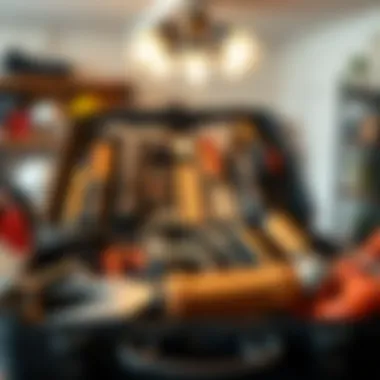
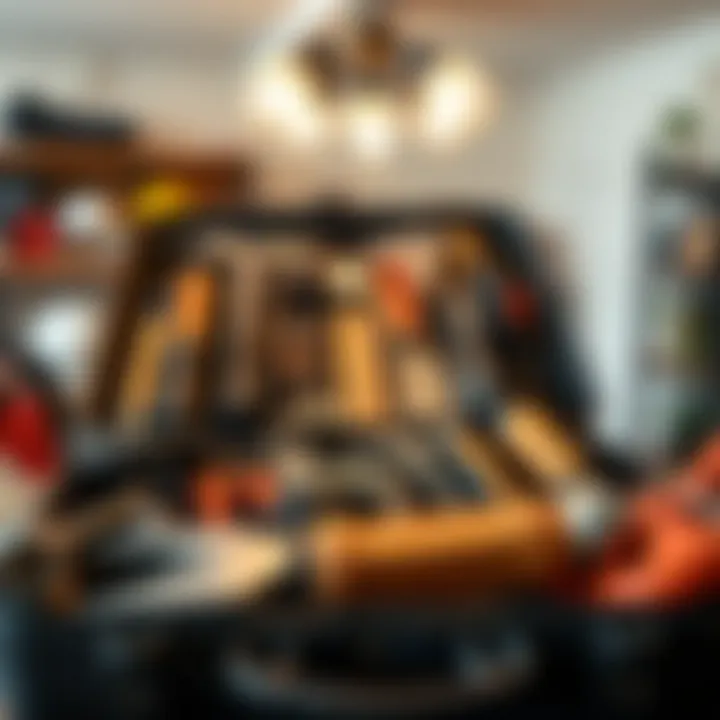
The key characteristic of a voltage tester is its simplicity in use. Many models are designed for ease, often just requiring you to touch the probe against the wire. A significant feature of modern testers is that they give a clear visual or audible signal, letting you know if it’s safe to proceed.
Failing to use a voltage tester could lead to dangerous situations. Hence, investing in a reliable one enhances not only your safety but your confidence as well.
Materials Needed for the Project
Light Fixture
The light fixture itself is obviously central to the project. Whether you choose a pendant light or a chandelier, the selection can dramatically change the aesthetic of your room.
A key characteristic to consider is the style and finish of the light fixture. Options range from minimalist designs to ornate ones, allowing you to express your personal taste. The unique feature of most modern fixtures is the integration of energy-efficient bulbs, which save on your electricity bill in the long run.
However, higher-end fixtures may come with hefty price tags. It's crucial to balance aesthetic appeal and functionality.
Mounting Bracket
A mounting bracket is essential for securing your light fixture to the ceiling. It acts as a support system, keeping your fixture stable and safely in position.
The key feature of a good mounting bracket is its durability. Typically made from metal, it withstands load and ensures the fixture doesn’t sag over time. A downside could be that some brackets require specific installation tools, which means additional planning.
Electrical Wire
Electrical wire is the backbone of your light installation. It's essential to use the right gauge wire to ensure safety and proper function. Commonly, residential applications use 14-gauge or 12-gauge wire.
The key characteristic of electrical wire is its insulation, which keeps current from leaking. Unique features include color-coded wires for easy identification of live, neutral, and ground wires. However, using incorrect gauge wire can lead to overheating, which can be a fire hazard.
Screws and Anchors
Finally, screws and anchors serve as the nitty-gritty elements that keep everything in place. Choosing the right screws based on the ceiling material is vital; drywall screws are typically used for drywall installations.
The key feature of good screws is their resistance to stripping and their corrosion-resistant coatings for longevity. Anchors, on the other hand, provide extra hold in drywall or ceilings that may not be strong enough to support fixtures on their own.
A downside may be that choosing poorly matched screws and anchors can lead to loose fixtures or, worse, them falling. So pick wisely to avoid unnecessary headaches.
Safety Precautions
When it comes to hanging ceiling lights, safety precautions cannot be overstated. Working with electricity poses inherent risks, and taking necessary steps can avoid accidents that could lead to injury or property damage. This section outlines crucial safety measures to ensure a secure and effective installation process.
Turning Off Power Supply
Before diving into the installation, the first step is to turn off the power supply. This simple yet vital action guards against electrical shocks. Locate the circuit breaker that controls the power to the room where you're working. Flip the switch to the ‘Off’ position, ensuring that power is completely cut off. It's also wise to use a voltage tester after turning off the circuit to confirm there's no residual electricity flowing to the light fixture. This practice mitigates risk, allowing for a safer environment to work in.
Using Safeguards While Working
Personal Protective Equipment
Utilizing personal protective equipment is key for safety while hanging ceiling lights. Items like safety goggles, gloves, and hard hats might not be top of the list for every DIY enthusiast, but they play a fundamental role. Safety goggles protect your eyes from dust and flying debris, while gloves offer hand protection from sharp edges or electrical components. In terms of 'beneficial choices,' wearing proper gear can drastically reduce the chances of injuries, making it a wise consideration. Although some may view such gear as cumbersome, the peace of mind they provide is unparalleled and definitely worth it.
Stabilizing Ladders
When working at heights, stabilizing ladders is non-negotiable. An unstable ladder can cause falls, so it’s crucial that the ladder is placed on a flat, secure surface and locked in place, if applicable. A key characteristic of stabilizing ladders is their design which often includes rubber feet or stabilizers, providing grip and balance. This makes the ladder safer to use when reaching for high fixtures. However, it's important to ensure that the ladder is rated for the weight of the user and any tools. Not all ladders are created equal, and using an inappropriate type can lead to unfortunate mishaps.
Work Environment Safety
Creating a safe work environment is a cornerstone of the installation process. This involves clearing the area of clutter, ensuring good lighting, and keeping tools organized and out of the way. An organized workspace minimizes tripping hazards, while adequate lighting helps you to see better and reduces the risk of making errors. The unique feature of maintaining a safe work environment is that it enhances focus and efficiency. However, it's essential to balance this with the need for adequate ventilation, especially if working with materials that might produce fumes. An optimal workspace not only boosts productivity but also contributes to your overall safety during electrical work.
Ensuring safety when hanging ceiling lights may seem like common sense, but overlooking these foundational steps can lead to unfortunate accidents. Taking the time to respect these precautions will reward you with a successful installation and the satisfaction of knowing you did it safely.
Preparing the Installation Site
Setting the stage for your new ceiling light involves more than just choosing the fixture. Preparing the installation site is crucial because it not only determines how well the light will function but also how it will enhance the overall aesthetic of the room. If you neglect this step, you might end up with a crooked or inadequately supported light fixture, diminishing the intended design and functionality of your space.
Assessing the Ceiling Structure
Before committing to a specific light fixture, it’s essential to assess the ceiling structure. This involves checking the type of materials used in your ceiling, whether it’s drywall, plaster, or something more weighty like wood beams. Each material has its own set of requirements for mounting fixtures securely.
- Drywall and Plaster Ceilings: These are quite common in residential homes. To install a ceiling light here, it’s usually best to find a ceiling joist, a sturdy piece of wood that can support the weight of the fixture. You can locate joists by using a stud finder or knocking gently on the ceiling to hear the difference in sound between the hollow spaces and the joists.
- Concrete Ceilings: If you live in a building with concrete ceilings, more robust anchors and possibly specific drill bits will be required for installation.
- Wood Ceilings: In cases where you have a wood ceiling, screws can generally be driven directly into the wood without the need for additional anchors. However, make sure the wood is in good condition to handle the load.
By carefully assessing the ceiling's structure, you not only secure the fixture but also set yourself up for an easier installation process, avoiding potential headaches down the line.
Determining Ideal Height and Location
The next step is to determine the ideal height and location for your ceiling light. This decision hinges on several factors, particularly the dimensions of the room and the desired ambiance.
- Room Size: In larger rooms, you may want to position the light fixture central to the space. For example, a dining room might benefit from a pendant or chandelier hung lower to create a warm, inviting atmosphere. In smaller rooms, it’s best to keep the fixture higher to avoid obstruction and give an illusion of height.
- Ceiling Height: If you have high ceilings, consider fixtures that draw the eye upward, such as a multi-tier chandelier. Standard ceiling heights often accommodate flush mounts or pendants that hang around 30-36 inches above tables and counters to maximize light distribution without encroaching on headspace.
- Functionality: Think about the primary activities that will take place under the light. For instance, reading nooks may require more focused lighting, and the fixture should reflect that. Conversely, ambient lighting should diffuse well across the room for more general use.
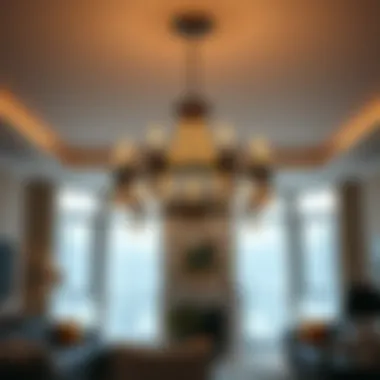
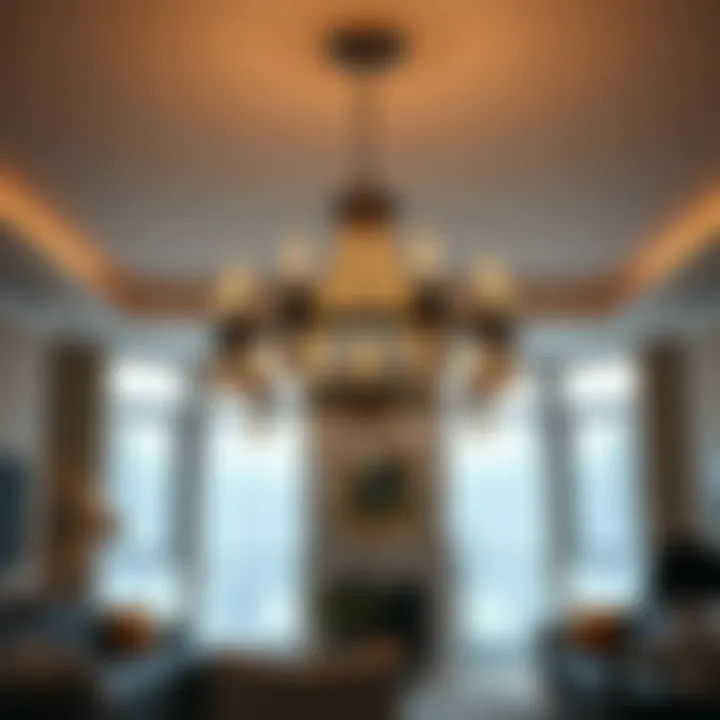
Ultimately, determining the right height and location isn't just about practicality; it also enhances the design. Finding the sweet spot will not only provide adequate light but also add character to your living space, making the installation not just a task, but a transformation.
The right lighting can turn a dull corner into a lively gathering spot, influencing both mood and functionality.
Wiring the Ceiling Light Fixture
Wiring a ceiling light fixture is a critical part of the installation process. Getting this aspect right ensures that your fixture works efficiently and safely. Properly done wiring not only extends the lifespan of your light but also reduces the risk of electrical issues like flickering lights or worse, electrical fires. Here, we will delve into the essentials of wiring the fixture correctly while also emphasizing techniques that can enhance the overall lighting effectiveness.
Understanding Electrical Wiring Basics
Before you grab those wires and get going, it's vital to grasp the basics of electrical wiring. At the heart of connecting your light fixture is an understanding of voltage, amperage, and how current flows. Each light fixture has a specific voltage requirement, quite often set at 120 volts in residential settings. Knowing that helps you to harness the right power to create your desired lighting atmosphere.
A few things to keep in mind:
- Voltage Ratings: Familiarize yourself with what voltage your new fixture requires. Avoid overloading circuits which can cause damage.
- Amperage: This refers to the amount of electricity a fixture uses. Ensure your circuit can withstand the load.
- Circuit Breakers: They serve as the safeguard preventing overloads. Knowing the load and ensuring it matches the breaker rating is essential.
Having this foundational knowledge enables you to work smarter and avoid excess risks.
Connecting the Wires Properly
Once you’ve got the basics down, connecting the wires becomes much clearer. Proper connections make all the difference in ensuring that your ceiling light operates correctly.
Identifying Wires: Live, Neutral, and Ground
The first step in making proper connections is to identify the types of wires involved: live, neutral, and ground. Each has its specific function in the connection.
- Live Wire: This wire carries current to the light fixture. It is typically black or red. Miswiring can lead to dangerous situations, including shocks.
- Neutral Wire: Usually white or gray, this wire completes the electrical circuit, allowing current to flow back to the source.
- Ground Wire: Often green or bare copper, this wire acts as a safety measure, directing excess electricity safely to the ground.
Understanding these key characteristics helps prevent mishaps and is a favored choice for any wiring project.
Securing Connections with Wire Nuts
After identifying your wires, it’s time to connect them securely. Wire nuts are a favored method, offering a reliable connection that stands the test of time. They twist onto the wire connections, creating an airtight seal preventing any exposure.
Advantages of using wire nuts include:
- Ease of Use: They are simple to apply, making connections quick while ensuring reliability.
- Secure Fit: Once twisted on properly, wire nuts hold tight, decreasing the risk of loose wires that can lead to flickering lights.
For folks who may worry about DIY wiring, wire nuts present a straightforward solution that balances safety and functionality. As a result, they become an invaluable part of any DIY toolkit.
Mounting the Light Fixture
Mounting the light fixture is a pivotal step in the process of hanging ceiling lights. It's not just about putting the light up and calling it a day; it's about ensuring that the fixture is securely attached and positioned well. A robust installation can prevent potential hazards such as electrical issues and falls, while also enhancing the overall aesthetic of your space. If the fixture isn't mounted properly, it could lead to flickering lights or, worse, the fixture falling altogether.
Securing the Fixture in Place
Once you've done all the prep work, it’s time to secure the fixture in its rightful place. First, make sure to refer to the instructions that came with your light fixture. Most of them have specific steps regarding how to attach the fixture to the mounting bracket or directly to the ceiling.
Give it a good check—ensure that all screws are snug and that nothing feels loose. If you're using anchors, make certain they are adequately set in the ceiling to hold the weight of the fixture. A well-mounted light fixture can last for years without issues. So, don't rush this part. Take your time to ensure everything is tight, secure, and appears straight.
Adjusting for Aesthetic Appeal
Now that your fixture is secured, it’s important to take a moment to think about how it fits into the overall look of the room. Adjusting for aesthetic appeal involves aligning the fixture not just perfectly but with an eye for design as well.
Aligning with Other Lighting
Aligning a ceiling fixture with other lighting elements in the room can create a harmonious atmosphere. If your space boasts a collection of wall sconces or table lamps, for instance, think about how their light emanates in relation to your newly hung ceiling light. This can contribute significantly to a well-balance ambiance in your room.
The unique quality of aligning fixtures is color temperature coherence. A warm bulb can beautifully complement soft glowing lamps, but a stark white light might clash with cozy hues. Finding that balance ensures your space feels curated and inviting.
Ensuring Even Distribution of Light
Ensuring even distribution of light is essential in creating a comfortable living environment. It's not enough for a light fixture to just look good; it needs to function well too. As you position your ceiling light, consider the layout of your room and where shadows may form.
A crucial aspect here is the placement of the bulb(s) within the fixture itself. For example, fixtures with multiple bulbs can provide a wider spread of light than single-bulb options. Moreover, you might want to use dimmers to offer more control over how bright or soft the lighting feels in the room.
Ultimately, achieving even light distribution contributes to an inviting atmosphere that enhances the usability of your space, whether it’s for working, entertaining, or simply relaxing at the end of a long day.
"A well-lit space can transform not just how you see a room, but how you feel within it."
Testing and Final Touches
Once you’ve maneuvered through the steps of mounting your ceiling light fixture, it’s time for the crucial phase of testing and final touches. At this stage, you want to ensure that everything works seamlessly, and the aesthetic is just right. Skipping this part can lead to unresolved issues, like flickering lights or an uneven ambiance, which can be a real pain in the neck. Let’s break down the essential components of this phase to guarantee a smooth, enjoyable experience with your newly installed lighting.
Ensuring Everything Functions Properly
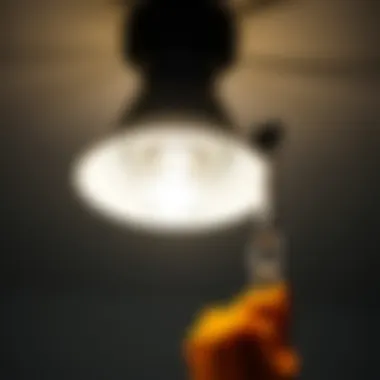
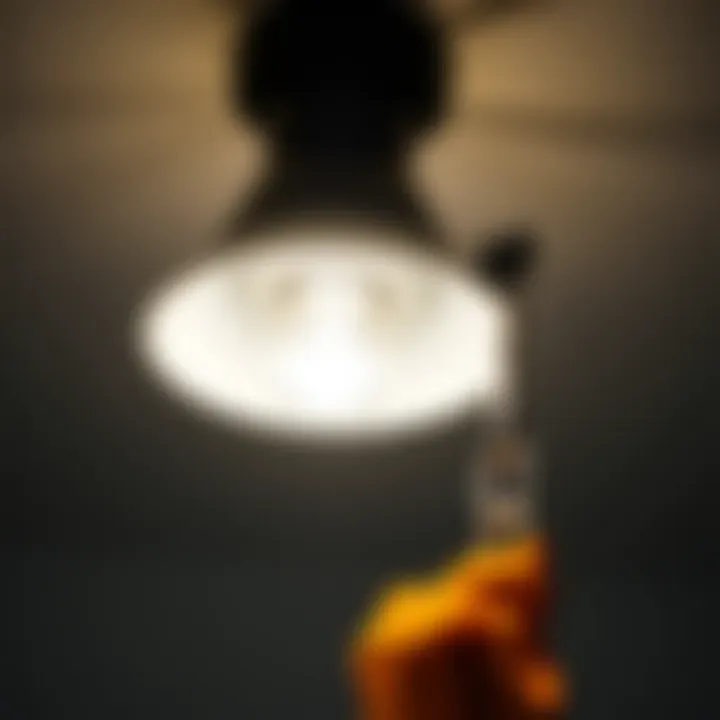
The first step in this process is to check that all functions as it should. After you’ve installed the fixture, switch on the power to see if the light works as intended. If it doesn’t light up right away, don’t panic. Such issues can range from a loose wire to a burned-out bulb. It’s essential to check these aspects thoroughly.
- Check the light bulbs: Sometimes, the simplest solution lies in a faulty bulb. Try substituting it with a new one to rule this out.
- Inspect connections: Ensure all wiring is correctly and securely connected. A mix-up here can result in the fixture not receiving power at all.
- Use a voltage tester: If you're still in the dark, employ a voltage tester to determine whether the fixture is getting power. It’s a handy tool that can save you a lot of guesswork.
By investing a few minutes to ensure proper functioning, you're not just saving a headache; you're also safeguarding the longevity of your installation.
Making Adjustments as Needed
After confirming that your light turns on without a hitch, the fun part begins—fine-tuning. Making minor adjustments can elevate your space’s aesthetic and ambiance dramatically. Remember, setting up lighting is not just about utility; it's about creating the right atmosphere. Here are two key areas to focus on:
Checking for Stability
At this stage, checking for stability is vital. You need to ensure that the fixture is secure and doesn’t wobble. An unstable fixture can be a safety hazard and also lead to wear and tear over time. To check stability, gently shake the fixture to see if it budges. If it does, re-evaluate the mounting screws and anchoring process.
The key characteristic here is support. You want the fixture to feel solid and steady, especially if it’s a heavier model like a chandelier. One way to enhance stability is to apply a bit of thread-locking glue to the screws, which prevents them from loosening over time. However, be cautious as over-tightening can crack light fixtures, so find that middle ground.
Fine-Tuning Angle and Height
After tackling stability, you might want to devote time fine-tuning the angle and height. This part is crucial because a light fixture placed incorrectly can cast shadows or fail to illuminate certain areas adequately. Think about where you want the light to focus, and adjust accordingly.
Adjustable fixtures are popular because they offer versatility, allowing you to tweak lighting direction as per your daily needs. This flexibility is a unique feature that enhances both practicality and style in your setup. However, too many adjustments can lead to unpredictability in distribution, so typically, it’s best to stick to minor alterations until you’ve found that sweet spot.
Closure
In wrapping up your installation, taking the time for this testing and adjustment phase ensures that your ceiling light not only functions correctly but also fits beautifully within your space. Pay attention to details like stability and light distribution, as they can make a world of difference in your newfound ambiance. When all is said and done, you can step back and bask in the glow of your impressive handiwork.
Maintenance and Troubleshooting
Maintaining and troubleshooting your ceiling lights is just as important as the installation process itself. A well-lit space contributes to both aesthetic appeal and functionality. Ignoring regular upkeep can lead to common issues, reduced performance, and even safety hazards. Therefore, understanding maintenance practices and troubleshooting solutions is indispensable for every homeowner or DIY enthusiast.
Regular Maintenance Practices
Regular maintenance is like clockwork; it keeps everything running smoothly. Here are some key practices:
- Routine Cleaning: Dust and debris can accumulate over time, not only altering the appearance of your lighting fixtures but also affecting their performance. Wipe down fixtures with a damp cloth regularly.
- Inspections: Periodically check the stability of your fixtures. Ensure all connections are tight and there’s no visible wear on the wires.
- Bulb Replacement: Keep an eye on the condition of your bulbs. Replace them as soon as you notice a dimming or flickering effect, which could be a sign of impending failure.
These practices ensure that your lighting systems not only enhance the ambiance of your space but also function effectively for years to come.
Common Issues and Solutions
Even with the best intentions, sometimes things don't go as planned. Here’s a look at some common issues you might encounter:
Flickering Lights
Flickering lights can be quite annoying and might signal an underlying electrical issue. Often caused by loose wires or bad bulbs, flickering needs prompt attention. It's crucial because it could indicate a poor connection, which may lead to bigger problems down the line. One of the distinctive features of flickering lights is their ability to distract, pushing one’s focus away from what’s truly important in a room.
- Advantages: Addressing flickering right away can prevent safety issues and ensure your lighting remains effective. This also extends the lifespan of your fixtures and appliances that depend on stable electricity.
- Disadvantages: If left unchecked, flickering could lead to electrical fires due to overheating wires.
Fixture Loosening Over Time
As time marches on, the fixtures installed may start to loosen. This can happen due to vibrations from other appliances or even temperature changes. A fixture that’s out of place doesn’t just look bad; it can also be a safety hazard.
- Key Characteristic: Loosening is often a gradual process, making it easy to overlook until the fixture falls.
- Advantages: Regular checks help to catch this issue early, saving potential costly repairs or replacements.
- Disadvantages: If not addressed swiftly, it can cause damage to the ceiling and the fixture itself, not to mention possible injuries.
Bulb Compatibility
Understanding bulb compatibility is key to maintaining illumination in any space. Using the wrong bulb could lead to inefficient lighting or, in some rare cases, electrical failures. This is especially vital when considering brighter options or specialty bulbs like those in chandeliers.
- Key Characteristic: Bulbs come in various wattages and types, and knowing what’s compatible with your fixtures can enhance their longevity.
- Advantages: When you use compatible bulbs, the fixtures operate better, and your overall lighting maintains a consistent look and feel.
- Disadvantages: Incorrect bulb use can lead to flickering, reduced brightness, or even overheating, impacting not only the bulb but the fixture as well.
Maintaining and troubleshooting your ceiling lights isn't optional; it's a necessary part of preserving their functionality and appearance. By keeping an eye on these common issues and treating them early, you're more likely to enjoy a safe and aesthetically pleasing environment in your living space.
Closure
Lighting plays a crucial role in enhancing the ambiance of a space, making the conclusion of this guide essential for solidifying the knowledge of how to successfully hang ceiling lights. In revisiting the pieces we’ve discussed, we can see that proper installation not only affects the functionality but also contributes significantly to the aesthetic appeal of your home.
When thinking about how to proceed with the installation, consider the various elements we've explored: from assessing your ceiling's structure to ensuring that all wiring is done accurately. Understanding these steps allows you to approach the installation not just as a task, but as an opportunity to elevate your living space into something more inviting and pleasing to the eye.
Recap of Key Steps
Before putting the tools away, let’s summarize the journey:
- Understanding Ceiling Lights: Recognize their importance and explore different types such as flush mounts, pendant lights, chandeliers, and recessed lighting.
- Gather the Right Tools and Materials: Ensure that you have everything from drills and wire strippers to the actual light fixtures at hand.
- Safety First: Always turn off the power first and make use of personal protective equipment to keep yourself safe.
- Prepare the Installation Site: Evaluate the ceiling and determine the best place to hang your light fixtures.
- Wiring the Fixture: Familiarize yourself with the basics of electrical wiring and properly connect the wires.
- Mounting the Fixture: Securely attach your new light fixture and adjust it for visual appeal.
- Testing and Final Touches: Ensure everything works as it should and adjust as necessary for an even light distribution.
- Maintenance and Troubleshooting: Regular check-ups can prevent common issues like flickering lights and fixture loosening.
Doing these steps right here ensures that you don’t just put a light in your space, but actually create an effect that uplifts the overall feel of the area.
Encouragement to Proceed with Confidence
Stepping into the world of home improvement can be intimidating, but remember, every expert was once a beginner. As you venture into hanging ceiling lights, give yourself a pat on the back for taking the initiative. Learning to transform your living space isn’t just about aesthetics; it’s about empowerment.
Do not hesitate to tap into resources and communities. Websites like reddit.com or tips from local hardware stores can offer valuable insights and support. Moreover, think of this project as an enriching experience, where each step teaches you both about the technicalities of wiring and the creative aspect of interior design. So gather those tools, take those measurements, and hang those lights with a sense of purpose and pride. Your newly lit space will be a testimony to your diligence and creativity.















